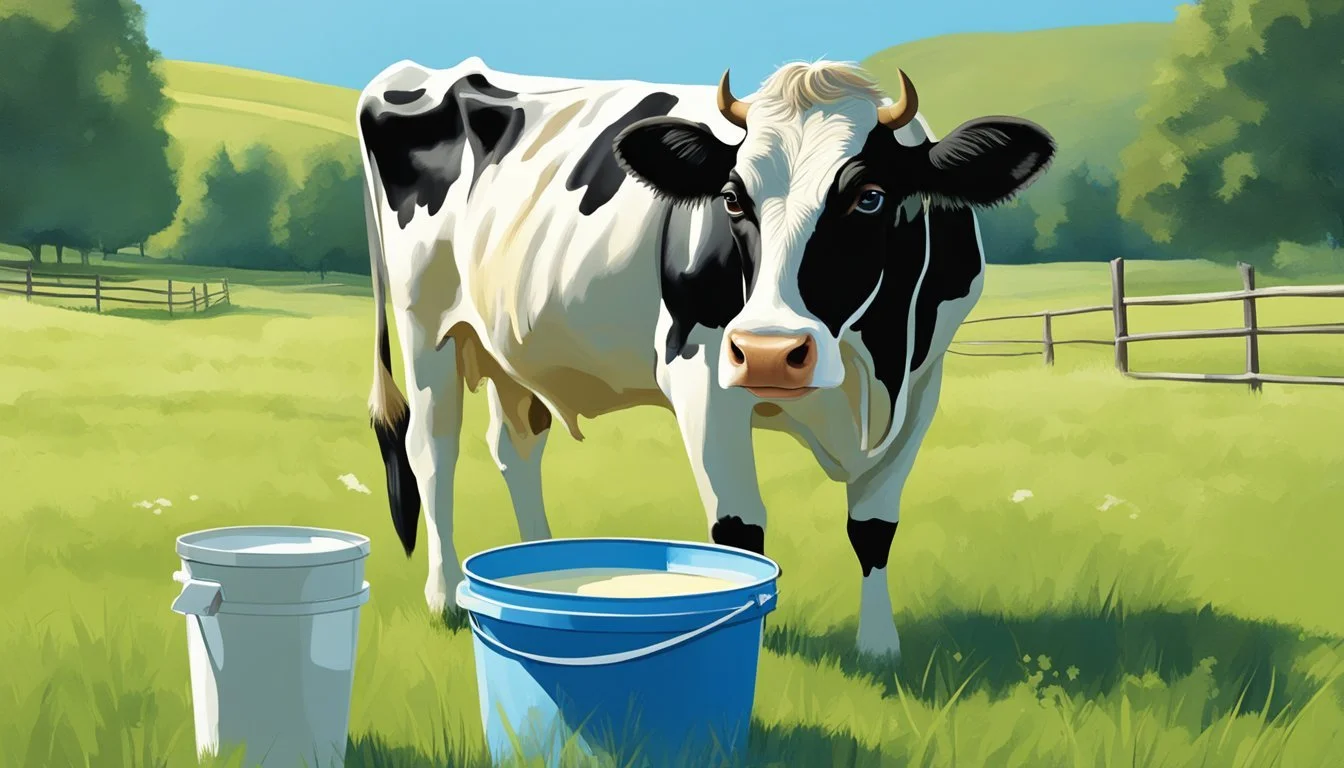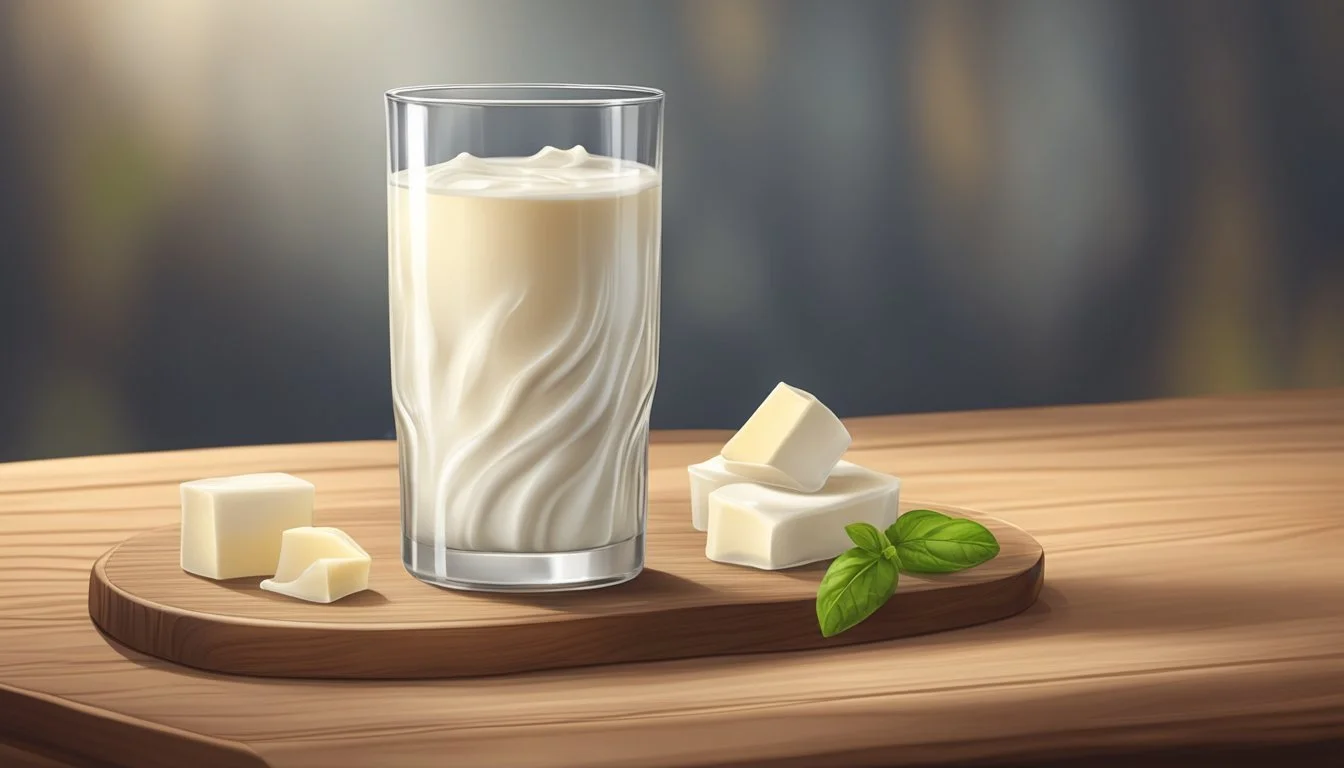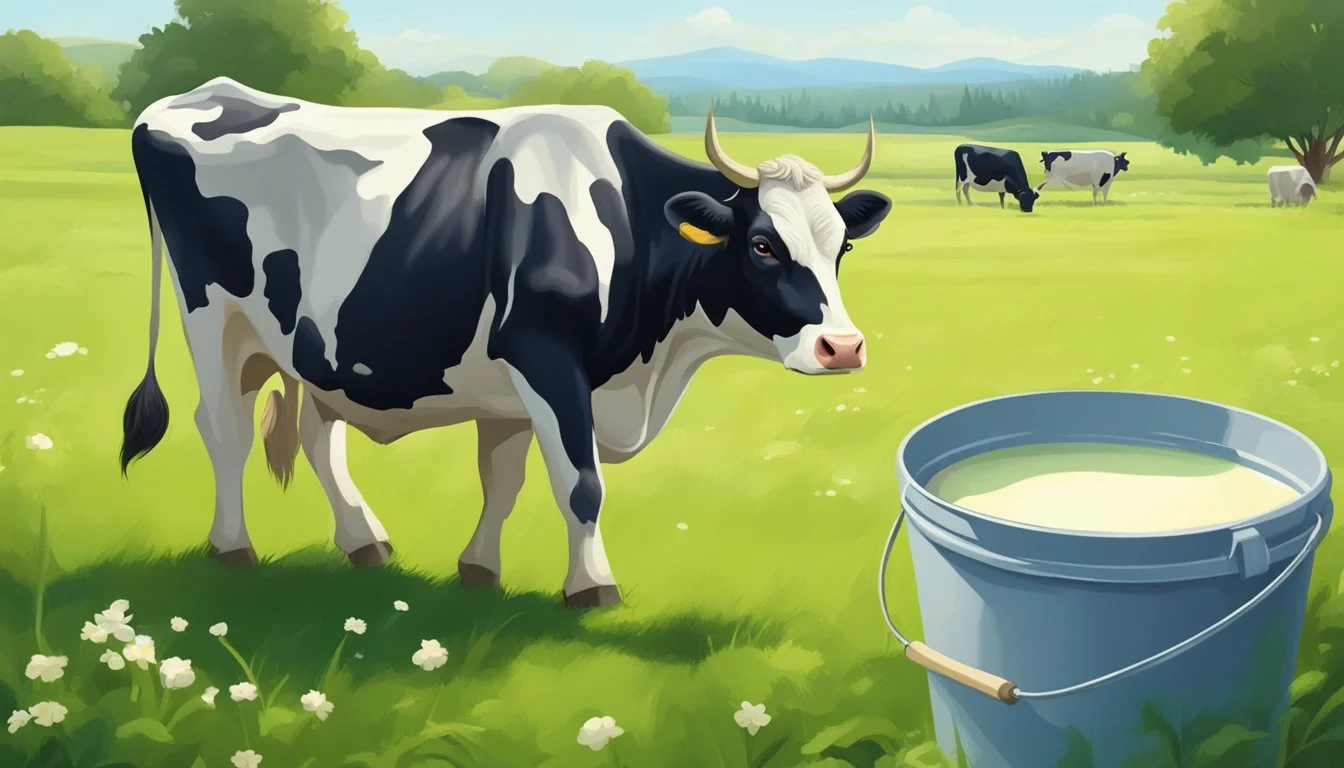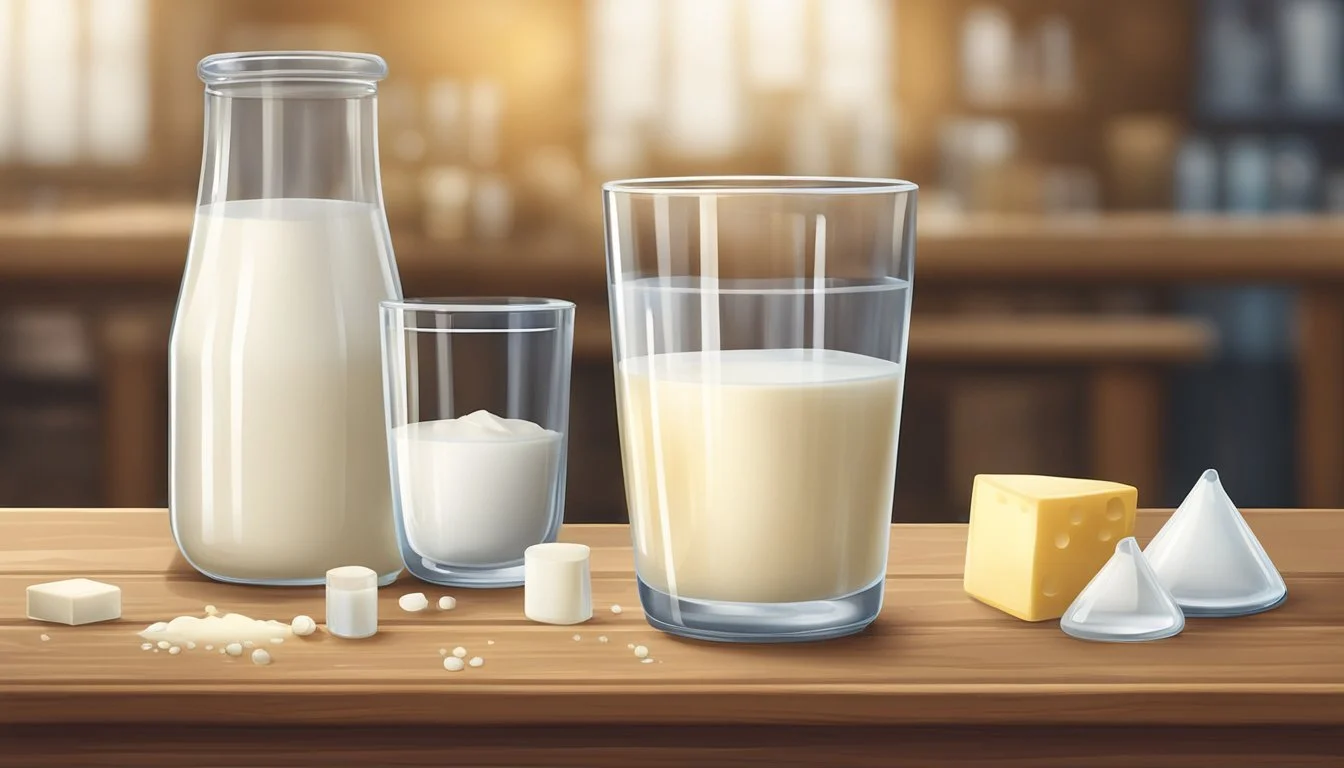The Science Behind Raw Milk's Creamy Texture
Unveiling the Physical Properties
Raw milk is often praised for its creamy texture, a characteristic that distinguishes it from its pasteurized counterpart. This texture arises from the milk's natural composition, which includes a higher fat content that contributes to its richer and more satisfying mouthfeel. Unlike processed milk, raw milk retains its cream layer, which consists of fat globules that naturally rise to the top, adding to the sensation of creaminess when consumed.
The science that accounts for the creamy texture of raw milk involves a delicate balance of its components. The fat globules, enveloped by a membrane of proteins and phospholipids, play a key role. In their natural state, these fat globules can move freely and contribute to the thickness and smooth consistency of the milk. Additionally, the presence of certain proteins in raw milk, especially casein and whey proteins, stabilizes the emulsion, further enhancing the creamy texture.
Unraveling The Science Behind Raw Milk's Creamy Texture unveils a captivating narrative that transcends misconceptions and delves into the remarkable interplay of nature, tradition, and culinary artistry. This journey into the heart of raw milk not only showcases its luscious creaminess but also sheds light on the profound impact it holds within the realm of traditional diets and culinary excellence.
Exploring the science behind raw milk cure and the intricacies of raw milk culinary education reveals the intricate balance of nutrients and natural richness that contribute to its velvety texture and unparalleled taste. Furthermore, venturing into the realm of raw milk soap making and savoring the delights of raw milk in various culinary creations underscores its versatility and the myriad ways it enriches our lives.
Dispelling misconceptions about raw milk and highlighting its positive environmental impact further illuminates its significance as a wholesome, natural ingredient. Embracing The Science Behind Raw Milk's Creamy Texture thus becomes a journey of discovery, appreciation, and reverence for the timeless art of harnessing nature's bounty to create an unparalleled culinary experience.
Understanding Raw Milk
Raw milk refers to milk that comes directly from an animal, typically cows, goats, or sheep, without undergoing pasteurization – a process that kills bacteria through heat. Unlike pasteurized milk, which is heated to at least 161°F for 15 seconds, raw milk retains its natural enzymes and beneficial bacteria because it is not subjected to such high temperatures.
Milk Composition:
Fat: Integral for creaminess; varies in content.
Proteins: Casein and whey, crucial for structure.
Carbohydrates: Lactose, or milk sugar, for sweetness.
Minerals: Including calcium and phosphorous.
Raw milk is inherently non-homogenized, meaning the milk fat globules are not mechanically broken down, allowing the cream to separate and rise to the top. This separation creates a distinct creamy layer that is traditionally associated with raw milk's texture.
The components of milk play a significant role in its properties:
Fat: A higher fat content contributes to a smoother, richer texture.
Proteins: Casein stabilizes fat emulsions, aiding in creaminess.
While some consumers claim a preference for raw milk's taste and texture, citing a creamier and more velvety consistency than commercial milk, scientific support on this matter varies. The perceived differences may be influenced by individual taste and textural sensitivity. It's important to note that the consumption of raw milk carries a risk of exposure to potentially harmful bacteria, which can be of particular concern to certain populations. Thus, safety precautions are recommended when handling and consuming raw milk.
The Role of Milk Constituents
Milk's creamy texture is largely due to its unique composition of constituents, each playing a crucial role in contributing to its sensory characteristics. The following elements are key:
Proteins: Primarily casein and whey proteins, they are responsible for milk's structure and stability. Casein, making up about 80% of the protein content in cow's milk, forms micelles that contribute to the creamy texture.
Fat: The emulsified lipids in milk are present as fat globules, surrounded by a membrane containing proteins and phospholipids. These fats provide richness and mouthfeel. Saturated fat is the most common type in milk, influencing its creaminess.
Carbohydrates: Lactose, the main carbohydrate, is a disaccharide that adds a slight sweetness and contributes to the body of milk.
Minerals: Calcium and phosphorus are present in significant quantities and interact with casein and whey, affecting the textural properties of milk.
Enzymes: Naturally occurring enzymes in milk can modify the structural aspects of proteins and fats, thus influencing texture.
A brief summary of milk constituents and their textural role:
Constituent Role in Texture Protein Structural stability, creaminess Fat Richness, mouthfeel Carbohydrates Body, slight sweetness Minerals Interact with proteins; texture influence Enzymes Modify structure of proteins and fats
The interplay between these components determines the overall creaminess and texture of milk, and slight variations in their concentrations can markedly alter the sensory experience. Each constituent’s role is essential and ensures that milk maintains its reputation as a nutritious and comforting beverage.
Factors Influencing Texture
Several factors contribute to the texture of raw milk, most notably its fat content and temperature. Milk consists of a water-based mixture housing various components, including lactose, proteins, minerals, and fat globules.
Fat globules are key to the creamy texture of milk. They are surrounded by a membrane that helps maintain their dispersed state within the liquid. Over time, these globules rise to the top, forming a distinct cream layer due to their lower density compared to the water phase of milk.
Temperature plays a significant role in this process. When milk is cooled, the fat globules become more rigid and stick together more easily. This leads to a faster creaming process. Conversely, heating milk, particularly during processes like pasteurization and homogenization, disrupts the membrane around fat globules. This can alter the texture, making it smoother and less likely to separate.
The incorporation of air also affects milk's texture. Mechanical agitation can introduce air, creating foam or froth. This is often desired in dairy products like whipped cream, where the aim is to incorporate air bubbles to achieve a light and airy consistency.
In summary, the consistency and texture of raw milk and its derivative products are largely determined by the fat content, which dictates the richness, and by temperature, which influences the behavior of fat globules and the extent of creaming. Heating processes, as well as the intentional introduction of air, can create various textures ranging from smooth and homogenous to light and frothy.
Science of Creaminess
Raw milk's creamy texture is a multifaceted characteristic defined by the interactions of fat globules and proteins, as well as changes that occur during heating. These interactions result in a sensation that is both rich and smooth.
Fat Globules and Creamy Consistency
In raw milk, the creaminess is largely due to fat globules enveloped by a membrane. These globules interact physically to provide a rich mouthfeel. The size and distribution of fat globules are crucial, with smaller ones typically providing a more uniform texture. Their ability to partly coalesce upon gentle chilling contributes to an increased perception of creaminess. Membranes surrounding the fat globules also play a role in stabilizing them, preventing complete coalescence and consequently maintaining the milk's creamy consistency.
Protein Interactions and Stability
Proteins in milk, primarily casein, and whey proteins, contribute significantly to its texture and stability. The proteins form a network that traps water and fat, providing a stable emulsion. This network's stability is pivotal for the creamy characteristics of milk. Casein micelles interact with fat globules, reinforcing the creamy texture. Additionally, proteins:
Inhibit sugar crystallization
Enhance the sensation of smoothness
When heated, whey proteins denature and interact with other milk constituents, enhancing the milk's thickness and creamy texture.
The Chemistry of Heating Milk
Heating raw milk initiates a complex series of chemical reactions that can alter its texture. When heated, proteins denature, which can either increase creaminess by creating a thicker consistency or lead to coagulation and a less smooth texture, depending on the heating conditions. The balance lies in gentle heating, which avoids denaturation that causes coagulation while encouraging the positive changes that enhance creaminess. Heat also affects the fat globules' membranes, promoting interactions that can add to the creamy sensation.
Differences Between Milk Types
When discussing the creaminess of milk, it's essential to consider the various types available, as they each contribute unique textures. Whole milk, which retains all its fat content, typically exudes the creamiest texture due to its higher fat percentage, generally around 3.25%. Conversely, skim milk has had nearly all its fat removed, leading to a thinner, less creamy consistency.
Heavy cream, known for its richness, is comprised of about 36-40% fat, making it the thickest and creamiest of dairy products. It's a staple in recipes that demand a luxurious and smooth texture.
Among milk alternatives, there's a growing variety tailored to dietary needs and preferences:
Almond milk: Made from ground almonds and water, it's naturally low in calories and fat, yet it lacks the creaminess of whole milk.
Soy milk: Extracted from soybeans, this option has a moderate creaminess and is often fortified to match the protein content of cow's milk.
Oat milk: Gained popularity for its environmental sustainability and naturally sweet, creamy texture similar to that of whole milk.
Coconut milk: Deriving from the flesh of coconuts, it imparts a rich, creamy texture with a distinct coconut flavor.
Milk Type Fat Content Creaminess Notable Characteristics Whole milk High Very creamy Skim milk Low Less creamy Heavy cream Very high Creamiest Significantly higher in fat Almond milk Low Slightly creamy Often enriched with vitamins Soy milk Moderate More creamy Protein-rich compared to other alternatives Oat milk Low-Moderate Creamy Sweet flavor, environmentally friendly Coconut milk High Creamy Coconut flavor, rich in texture
Each type's texture and creaminess level are influenced by its processing and fat content, providing a range of options to satisfy both culinary and dietary preferences.
Methods of Milk Preparation
Preparing milk to enhance its creamy texture involves specific techniques chiefly used in creating a range of coffee-based beverages. Mastery in these methods transforms ordinary milk into a rich, smooth, and velvety component essential for the perfect cup.
Steaming and Frothing Techniques
Steaming milk involves heating it with a steam wand, a tool typically found on espresso machines. The barista immerses the wand just below the surface of the milk in a pitcher. This process introduces heat and air into the milk, creating steam and froth simultaneously.
Heating: Milk is heated to the optimal temperature, typically between 150°F to 155°F (65°C to 68°C), which is crucial for achieving the desired consistency without burning the milk.
Aeration: By keeping the steam wand tip just below the milk's surface, air is incorporated, contributing to the froth's formation.
Creating Microfoam for Velvety Texture
Creating microfoam is essential for a velvety texture in beverages like lattes and cappuccinos. Microfoam refers to milk foam with fine, uniform bubbles, making it appear glossy and feel silky on the palate.
Technique: Once the milk reaches the proper temperature, the barista moves the steam wand deeper into the pitcher, maintaining a vortex to evenly distribute the heat and achieve a uniform texture.
Consistency: The goal is to create a tight, consistent microfoam that integrates seamlessly with coffee, enhancing the drink's body and flavor.
A properly steamed milk with well-crafted microfoam elevates the drinking experience, providing a tactile sensation that complements the beverage's taste.
Milk in Coffee Culture
In coffee culture, milk isn't just an add-in; it plays a pivotal role in transforming a simple shot of espresso into various beloved beverages. Lattes, cappuccinos, and macchiatos all share espresso as their base, yet it's the milk's creamy texture that differentiates these drinks.
Espresso acts as the strong, flavorful foundation.
Latte incorporates a larger amount of steamed milk with a light layer of froth.
Cappuccino offers a balance with equal parts espresso, steamed milk, and milk froth.
Macchiato typically features just a dollop of milk foam atop an espresso.
The secret to the perfect creamy texture lies in the technique of milk texturing. This involves using an espresso machine's steam wand to heat and aerate the milk, creating a rich and velvety microfoam. The sweetness in milk is naturally enhanced when heated, adding a soft, sweet undertone to the bold espresso.
Cafes around the world showcase their barista's skills through latte art; intricate designs on the surface of a latte demonstrating mastery in milk texturing. Achieving this delicate art form requires skill and practice, as the frothed milk must be poured with precision.
In terms of equipment, a reliable espresso machine with a steam wand is essential. Baristas must control temperature and steam pressure to avoid scalding the milk, ensuring the milk's creaminess is preserved while its natural sweetness is brought to the forefront.
The interplay between espresso and milk is not only a testament to the beverages' flavors but also to the artistry and science behind coffee culture's most treasured creations.
Practical Applications in Beverages
The creamy texture of raw milk differentiates beverages such as lattes, cappuccinos, and macchiatos, creating a unique sensory experience. Mastering milk's textural transformation is key to beverage artistry.
The Art of Crafting a Perfect Latte
In the creation of a perfect latte, baristas pay special attention to the texturing process of raw milk. This involves steaming the milk to a velvety consistency that enriches the final drink. Sweetness is also enhanced as heat interacts with the milk sugar (lactose), ensuring the latte's flavor is full-bodied.
Cappuccinos and Foam Quality
The hallmark of a great cappuccino is high-quality foam. Milk froth should be dense yet creamy, a product of introducing air to the milk at the right temperature and duration. Baristas often use an app to perfect temperatures and timings, catering to personal preferences for foam consistency.
Macchiatos and Milk-Texture Variations
Macchiatos showcase the contrast between strong espresso and the delicate touch of milk. Minimal milk is used, but texture variations are still crucial. Depending on the recipe, the froth may range from light and airy to rich and creamy, displaying the versatility of raw milk's textural qualities.
Technical Aspects of Texturing Milk
In the technical realm of texturing milk, key components such as the stability of frothed milk, and precise temperature control are critical in achieving a consistent and desirable texture. These factors are interdependent in milk steaming, a process essential for creating the perfect froth for various coffee beverages.
Understanding the Stability of Frothed Milk
When texturing milk, a barista introduces steam and air into milk to create froth, a process called frothing or steaming. The goal is to achieve a stable emulsion of air bubbles within the liquid that is both creamy and consistent. Steam pressure is crucial here; it unfolds milk proteins which then stabilise the air bubbles, contributing to the milk's rich texture. A common troubleshooting tip for a barista is ensuring the steam wand is at the right depth—typically kept just below the surface of the milk at the beginning of steaming—to effectively incorporate air without creating large, unstable bubbles.
The Importance of Temperature Control
Temperature control plays a pivotal role in texturing milk. The optimal temperature range for steaming milk is between 60°C to 70°C (140°F to 160°F), where proteins and fats react in a way that allows for the perfect froth formation. A thermometer is often used to monitor the milk's temperature during steaming. If the milk is too cold, it won't froth well, whereas overheated milk can scald, leading to a burnt taste and a poor texture. Maintaining the correct temperature ensures the consistency of the froth and ultimately the quality of the beverage.
By emphasizing these technical aspects, one can master the delicate balance of steam pressure, air incorporation, and temperature that defines the art of milk texturing.
Troubleshooting Common Issues
When working with raw milk to achieve a creamy texture, one may encounter challenges such as burnt milk or over-frothing. Understanding how to address these problems is key to crafting the perfect velvety texture that is neither too airy nor scalded.
Avoiding Burnt Milk and Over-Frothing
Burnt milk not only affects the taste but also destroys the delicate, creamy consistency desirable in many dairy products. To prevent this:
Use a Thermometer: Always monitor the temperature carefully, especially when steaming milk. Aim for not exceeding 150°F (65°C) to avoid burning.
Heat Gradually: Apply gentle heat to avoid sudden temperature spikes. A double boiler can be an effective tool to control heat.
Over-frothing results in a foam that is too stiff and can ruin the balance of a dairy beverage. To avoid this:
Don't Overfill: Use a pitcher that's large enough to prevent milk from overflowing but sized to suit the amount of milk being frothed.
Vortex Method: Create a whirlpool effect by positioning the steam wand near the pitcher's wall. It should not break the surface, to maintain a consistent force throughout the frothing process.
Crafting Consistent Milk Texture
To achieve a consistent, velvety foam across different batches of milk, consider the following steps:
Regular Equipment Maintenance: Clean and maintain the steam wand and frothing equipment to ensure it performs optimally.
Stabilizers: Experiment with natural stabilizers, like carrageenan, if the milk foams inconsistently. They can help to maintain the foam's structure.
These methods provide a foundation for troubleshooting common issues experienced when steaming and frothing raw milk. A combination of proper technique and understanding the properties of raw milk will consistently yield a creamy and desirable texture.
Health and Safety Considerations
When discussing the health and safety aspects of raw milk, it's crucial to understand its components and how they can be affected by pathogens. Raw milk contains a wealth of nutrients including proteins, carbohydrates in the form of milk sugar or lactose, fats, and minerals, which collectively contribute to its creamy texture.
Microbiological Risks Raw milk can harbor various pathogens posing health risks.
Bacteria: E. coli, Listeria, and Salmonella, known to cause foodborne illnesses.
Safety Measures: Refrigeration and proper hygiene during milking reduce contamination risk.
Chemical Hazards
Contaminants: Pesticides or antibiotics from cattle treatment may be present.
Regulation: Strict controls are in place to limit chemical residue in milk.
Nutritional Comparison:
Raw Milk Pasteurized Milk Mineral Content Usually higher May decrease slightly Fat Content Natural levels Often standardized Milk Sugar (Lactose) Unchanged Unchanged Carbohydrates Unchanged Unchanged
Dietary Needs People with specific dietary needs should assess the benefits against potential risks. Pasteurization is a process that heats milk to destroy harmful bacteria without significantly affecting the nutritional value.
Various agencies monitor milk safety, setting guidelines for pathogen levels and permissible chemical residues to ensure consumer safety.
In balancing the creamy texture that many consumers enjoy with safety concerns, individuals and manufacturers must consider these health and safety factors. The choice between raw and pasturized milk should be informed by an awareness of potential microbiological and chemical hazards, alongside a consideration of dietary needs and preferences.











